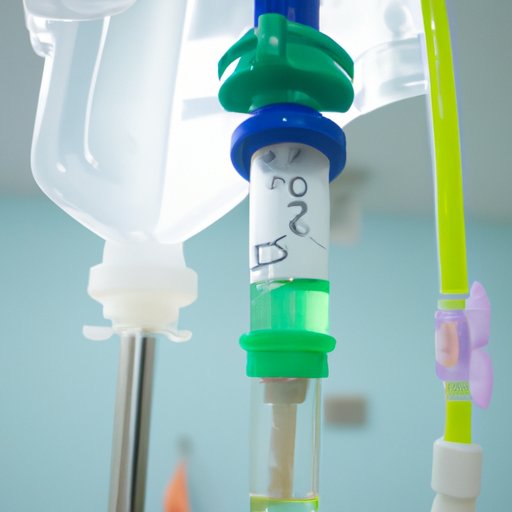
I. Introduction
When it comes to proper nutrition, diet and supplements often come to mind. However, some individuals have a condition where they cannot eat by mouth or their body does not absorb nutrients properly. In such cases, medical professionals can use parenteral nutrition to sustain them. This article provides a comprehensive overview of parenteral nutrition, including the definition, who needs it, the benefits and risks, administration process, differences between parenteral and enteral nutrition, history, and living with parenteral nutrition.
II. Defining parenteral nutrition
Parenteral nutrition refers to a nutritional therapy where nutrients are given directly to a person’s bloodstream via a feeding tube, bypassing the digestive system. This process is necessary when an individual cannot eat by mouth or has a medical condition where the body cannot absorb nutrients properly. However, many people confuse enteral nutrition with parenteral nutrition, as they both refer to nutritional supplements. Enteral nutrition is when supplements are given through a feeding tube placed in the digestive system. The key difference is that in parenteral nutrition, the supplements bypass the digestive system entirely.
III. Who needs parenteral nutrition and why
Parenteral nutrition is necessary for individuals who cannot eat by mouth due to conditions such as cancer, gastrointestinal disorders, Crohn’s disease, or short bowel syndrome. It may also be necessary when the body cannot absorb nutrients through the digestive system, such as in cases of liver or kidney failure. Parenteral nutrition sustains proper nutrition by providing the necessary vitamins, minerals, and macronutrients, such as protein, carbohydrates, and fats, directly to the bloodstream.
IV. Understanding the risks and benefits of parenteral nutrition
The benefits of parenteral nutrition are evident as it provides a source of nutrition for individuals who cannot obtain it through typical methods. However, like any medical treatment, there are potential side effects, risks, and complications that must be considered. Some of the risks include infection, blood clots, liver and gallbladder disease, bone demineralization, and fluid and electrolyte imbalances. Despite these risks, overall, parenteral nutrition can enhance the quality of life and longevity of individuals who need it.
V. The process of administering parenteral nutrition
The clinical process of administering parenteral nutrition involves determining the nutritional needs of the individual and creating a formulation of the necessary nutrients. The mixture is then delivered through a central venous catheter, which is a tube inserted into a large blood vessel near the heart. The catheter is carefully monitored to prevent infection and dislodgement, and the mixture is adjusted as necessary based on the individual’s nutritional needs and response to therapy.
VI. Parenteral vs. enteral nutrition: What is the difference?
Parenteral nutrition bypasses the digestive system entirely and provides nutrition directly to the bloodstream, while enteral nutrition provides the supplements via a feeding tube placed in the digestive system. The appropriate therapy is determined by the individual’s condition and the ability of the digestive system to absorb nutrients. Parenteral nutrition is necessary for individuals who cannot obtain nutrients through the digestive system, while enteral nutrition is appropriate for individuals who can eat or have some digestive function.
VII. The history of parenteral nutrition
The development of parenteral nutrition can be traced back to the early 20th century, where intravenous feeding was first explored. However, it wasn’t until World War II, where feeding soldiers with battle injuries through parenteral therapy highlighted the importance of such a method. The field of parenteral nutrition continued to develop and improve over the years, where today, it is a critical treatment option for individuals who cannot eat by mouth or have restricted digestion.
VIII. Living with parenteral nutrition
Living with parenteral nutrition can be challenging, especially in terms of daily life and creating a support network. Many patients and their families struggle to adapt to the changes that come with parenteral nutrition, such as adjusting to the feeding regimen, maintaining catheter hygiene, and dealing with potential side effects. It is crucial to have a support network that can help the individual cope with these challenges. Connecting with support groups, medical professionals, and dieticians can be helpful in this regard.
IX. Conclusion
Parenteral nutrition is a vital treatment option for individuals who cannot eat by mouth or cannot absorb nutrients through the digestive system. While there are risks involved, its benefits significantly outweigh them, and it provides a way for individuals to maintain proper nutrition and enhance their overall quality of life. It is crucial to work with medical professionals to monitor the therapy and adjust it as necessary. A supportive network can also help individuals and their families adapt to the changes that come with parenteral nutrition, improve their quality of life over time, and enhance longevity.





